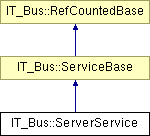
#include <it_bus/server_service.h>
Inheritance diagram for IT_Bus::ServerService:

Definition at line 30 of file server_service.h.
Public Member Functions | |
| virtual void | register_servant (Servant &servant, const String &port_to_register=IT_BUS_ALL_PORTS)=0 |
| Registers a servant, optionally associated with a specific port name. | |
| virtual void | register_default_servant (Servant &servant, const String &port_to_register=IT_BUS_ALL_PORTS)=0 |
| Registers a default servant, optionally associated with a specific port name. | |
| virtual Reference | get_reference_with_id (const String &instance_id, const String &port_to_register=IT_BUS_ALL_PORTS)=0 |
| Registers a new addressing context for the default servant to support. | |
| virtual WS_Addressing::EndpointReferenceType | get_endpoint_reference_with_id (const String &instance_id, const String &port_to_register=IT_BUS_ALL_PORTS)=0 |
| Registers a new addressing context for the default servant to support. | |
| virtual void | shutdown (IT_Bool wait_for_completion)=0 |
| Shutdown the service. | |
| virtual IT_Bool | is_transient () const =0 |
| Return an indicator of whether the service is transient. | |
|
||||||||||||
|
Registers a new addressing context for the default servant to support. This will throw a Bus Exception if no default servant has been registered for the port specified. Use this method when you want to activate a new service against a default servant. The EndpointReferenceType returned contains addressing based on the instance_id passed in.
|
|
||||||||||||
|
Registers a new addressing context for the default servant to support. This will throw a Bus Exception if no default servant has been registered for the port specified. Use this method when you want to activate a new service against a default servant. The Reference returned contains addressing based on the instance_id passed in.
|
|
|
Return an indicator of whether the service is transient.
|
|
||||||||||||
|
Registers a default servant, optionally associated with a specific port name. Use this method when you want to share a single Servant across multiple Services of the same type. It requires that the Servant implementation uses Addressing Context at runtime to distinguish between endpoints.
|
|
||||||||||||
|
Registers a servant, optionally associated with a specific port name. Use this method when multiple servants, associated with different port names, must be registered under the same service.
|
|
|
Shutdown the service.
|
 1.3.9.1
1.3.9.1